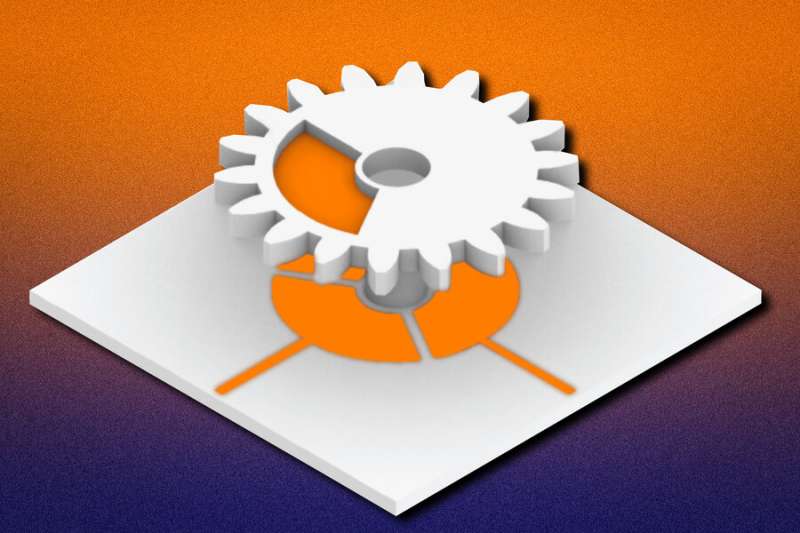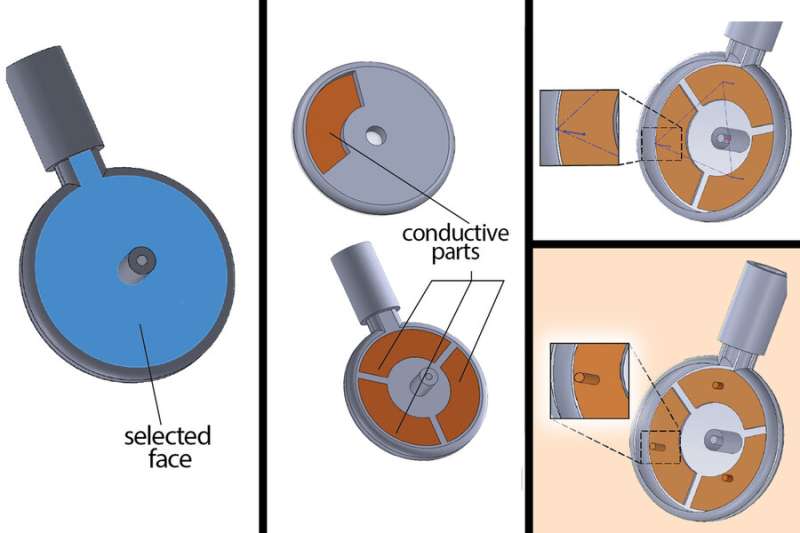
Integrating sensors into rotational mechanisms could make it possible for engineers to build smart hinges that know when a door has been opened, or gears inside a motor that tell a mechanic how fast they are rotating. MIT engineers have now developed a way to easily integrate sensors into these types of mechanisms, with 3D printing.
Even though advances in 3D printing enable rapid fabrication of rotational mechanisms, integrating sensors into the designs is still notoriously difficult. Due to the complexity of the rotating parts, sensors are typically embedded manually, after the device has already been produced.
However, manually integrating sensors is no easy task. Embed them inside a device and wires might get tangled in the rotating parts or obstruct their rotations, but mounting external sensors would increase the size of a mechanism and potentially limit its motion.
Instead, the new system the MIT researchers developed enables a maker to 3D print sensors directly into a mechanism’s moving parts using conductive 3D printing filament. This gives devices the ability to sense their angular position, rotation speed, and direction of rotation.
With their system, called MechSense, a maker can manufacture rotational mechanisms with integrated sensors in just one pass using a multi-material 3D printer. These types of printers utilize multiple materials at the same time to fabricate a device.
To streamline the fabrication process, the researchers built a plugin for the computer-aided design software SolidWorks that automatically integrates sensors into a model of the mechanism, which could then be sent directly to the 3D printer for fabrication.
MechSense could enable engineers to rapidly prototype devices with rotating parts, like turbines or motors, while incorporating sensing directly into the designs. It could be especially useful in creating tangible user interfaces for augmented reality environments, where sensing is critical for tracking a user’s movements and interaction with objects.
“A lot of the research that we do in our lab involves taking fabrication methods that factories or specialized institutions create and then making then accessible for people. 3D printing is a tool that a lot of people can afford to have in their homes. So how can we provide the average maker with the tools necessary to develop these types of interactive mechanisms? At the end of the day, this research all revolves around that goal,” says Marwa AlAlawi, a mechanical engineering graduate student and lead author of a paper on MechSense.
AlAlawi’s co-authors include Michael Wessely, a former postdoc in the MIT Computer Science and Artificial Intelligence Laboratory (CSAIL) who is now an assistant professor at Aarhus University; and senior author Stefanie Mueller, an associate professor in the MIT departments of Electrical Engineering and Computer Science and Mechanical Engineering, and a member of CSAIL; as well as others at MIT and collaborators from Accenture Labs. The research will be presented at the ACM CHI Conference on Human Factors in Computing Systems.
Built-in sensing
To incorporate sensors into a rotational mechanism in a way that would not disrupt the device’s movement, the researchers leveraged capacitive sensing.
A capacitor consists of two plates of conductive material that have an insulating material sandwiched between them. If the overlapping area or distance between the conductive plates is changed, perhaps by rotating the mechanism, a capacitive sensor can detect resulting changes in the electric field between the plates. That information could then be used to calculate speed, for instance.

“In capacitive sensing, you don’t necessarily need to have contact between the two opposing conductive plates to monitor changes in that specific sensor. We took advantage of that for our sensor design,” AlAlawi says.
Rotational mechanisms typically consist of a rotational element located above, below, or next to a stationary element, like a gear spinning on a static shaft above a flat surface. The spinning gear is the rotational element and the flat surface beneath it is the stationary element.
The MechSense sensor includes three patches made from conductive material that are printed into the stationary plate, with each patch separated from its neighbors by nonconductive material. A fourth patch of conductive material, which has the same area as the other three patches, is printed into the rotating plate.
As the device spins, the patch on the rotating plate, called a floating capacitor, overlaps each of the patches on the stationary plate in turn. As the overlap between the rotating patch and each stationary patch changes (from completely covered, to half covered, to not covered at all), each patch individually detects the resulting change in capacitance.
The floating capacitor is not connected to any circuitry, so wires won’t get tangled with rotating components.
Rather, the stationary patches are wired to electronics that use software the researchers developed to convert raw sensor data into estimations of angular position, direction of rotation, and rotation speed.
Enabling rapid prototyping
To simplify the sensor integration process for a user, the researchers built a SolidWorks extension. A maker specifies the rotating and stationary parts of their mechanism, as well as the center of rotation, and then the system automatically adds sensor patches to the model.
“It doesn’t change the design at all. It just replaces part of the device with a different material, in this case conductive material,” AlAlawi says.
The researchers used their system to prototype several devices, including a smart desk lamp that changes the color and brightness of its light depending on how the user rotates the bottom or middle of the lamp. They also produced a planetary gearbox, like those that are used in robotic arms, and a wheel that measures distance as it rolls across a surface.
As they prototyped, the team also conducted technical experiments to fine-tune their sensor design. They found that, as they reduced the size of the patches, the amount of error in the sensor data increased.
“In an effort to generate electronic devices with very little e-waste, we want devices with smaller footprints that can still perform well. If we take our same approach and perhaps use a different material or manufacturing process, I think we can scale down while accumulating less error using the same geometry,” she says.
In addition to testing different materials, AlAlawi and her collaborators plan to explore how they could increase the robustness of their sensor design to external noise, and also develop printable sensors for other types of moving mechanisms.
More information:
MechSense: www.dropbox.com/s/3yrp0jvadtzu … w/mechsense.pdf?dl=0
This story is republished courtesy of MIT News (web.mit.edu/newsoffice/), a popular site that covers news about MIT research, innovation and teaching.
Citation:
3D-printed revolving devices can sense how they are moving (2023, March 16)
retrieved 16 March 2023
from https://techxplore.com/news/2023-03-3d-printed-revolving-devices.html
This document is subject to copyright. Apart from any fair dealing for the purpose of private study or research, no
part may be reproduced without the written permission. The content is provided for information purposes only.
Stay connected with us on social media platform for instant update click here to join our Twitter, & Facebook
We are now on Telegram. Click here to join our channel (@TechiUpdate) and stay updated with the latest Technology headlines.
For all the latest Technology News Click Here
For the latest news and updates, follow us on Google News.
